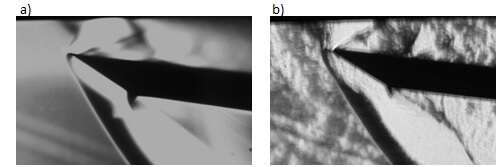An investigation looking into the interaction of an expansion fan and a turbulent boundary layer is presented. The study is limited to an ideal two-dimensional characterisation of the mechanism by which an expansion fan can alter visible flow features in a turbulent boundary layer, both fore and aft of the interaction region. The turbulent boundary layer in question, on the wall of a supersonic wind tunnel, is of the order of 10 mm in height.
A wedge was designed to generate a centred expansion fan propagating towards the wall. The frame of the wedge allowed for two degrees of freedom, explicitly, the angle to the free-stream, and the height from the wall. The experimentation includes shadowgraph and schlieren imagery of a wedge in the Mach range of 2.5 to 3.2, within a boundary layer, as well as in the supersonic free stream. Figure 1 shows schlieren images of a single test case. The time average effects of the flow are limited using a 1 μ-second flash compared to a continuous light source.
The initial premise was to establish the changes to the boundary layer height as the expansion fan interacted with it. It was evident that the pre-interaction region was important. The appearance of a compression upstream of the expansion fan, within a turbulent boundary layer, is a previously undiscovered phenomenon. When the wedge is in the free stream, there is an apparent thinning of the boundary layer in the interaction region. As the leading edge of the wedge is lowered to within the boundary layer, the upstream compression is detectible. The position of the wave, relative to the expansion fan, advances upstream with decreasing height, increasing angle, and decreasing Mach number. This wave is visible as a darker region to the left of the expansion, above the wedge in Figure 1. The airflow is at Mach 2.5, from left to right, with a shock and expansion wave below and above the angled wedge respectively. The inclusion of focusing schlieren, and laser sheet with particle injection will help by capturing the images with minimal disturbances, and three dimensional effects.
The exact velocity and turbulence variations of the boundary layer, in the wind tunnel, are unknown. CFD has been done providing similar trends to the experimentation. The presence of the compression, upstream of the expansion fan, is akin to the shock structure within a separation region upstream of a ramp at the wall. The study is currently underway.

Figure 1: Schlieren photographs having flow times of a) 1/60 sec and b) 2 μsec with the wedge at 5 degrees, 7 mm from the wall at Mach 2.5

